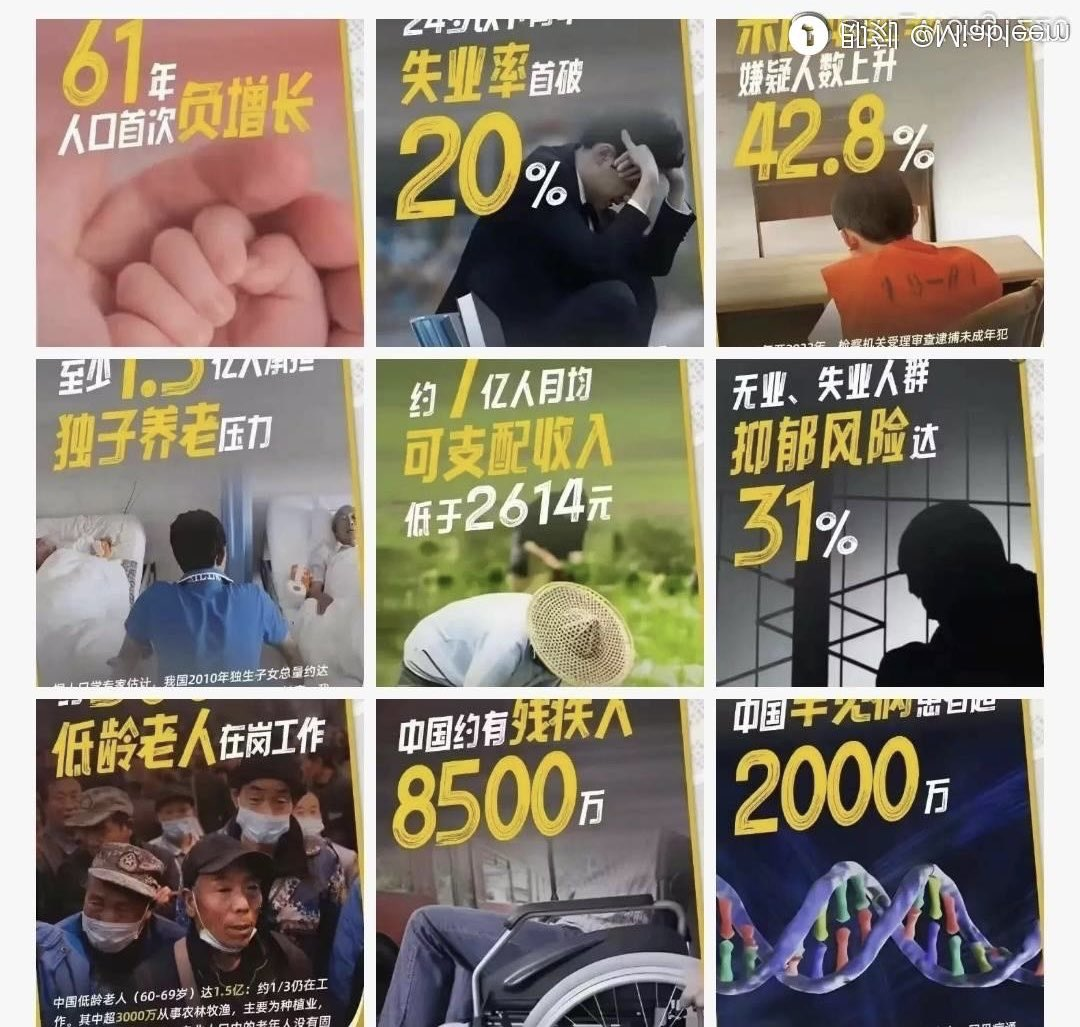This week, a striking series of infographics meant to highlight social issues such as poverty, disability, depression, youth unemployment, and elder care were scrubbed from Weibo, leaving only the blank gray boxes that Weibo uses to signal censored image content. The original series, which featured colorful graphics and bold statistics, was screenshotted and preserved by some Weibo users before it disappeared. What was perhaps most surprising about the censorship was that the images came from Sohu News, a fairly mainstream media outlet, and most of the statistics were drawn from major media outlets and Chinese government sources such as the State Council, the National Bureau of Statistics, and the National Development and Reform Commission.
The infographics were published by Sohu News as part of their “Spotlight Project,” a public welfare project that aims to shine a spotlight on some of China’s most pressing socio-economic problems, and on the people and organizations endeavoring to solve them. The mission statement on the website for “Spotlight Project” (追光计划, Zhuīguāng Jìhuà) describes it thus:
The “Spotlight Project” is an innovative public welfare IP project created by Sohu News. The focus is on constructive action that combines the power of the media with the power of government organizations. Through a broad variety of online and offline content, we intend to “shine a spotlight” on public issues and make a meaningful contribution to the public welfare. We look forward to sharing the spotlight with you, and helping more people to see the light. [Chinese]
The screenshot below shows the nine images as they appeared before they were censored. Some of the eye-catching statistics include: “Youth unemployment tops 20%,” “Juvenile criminal prosecutions up 42.8%,” “Unemployed individuals at 31% risk of depression,” and “China has 85 million disabled individuals.” (See below for full images and more detailed translations.)

The screenshot below shows that by June 15, all of the infographics had disappeared from Weibo and been replaced by blank gray boxes, signaling deleted image content. When the images were still visible, Weibo user @掘藏师_杜瓦 shared the nine images, with the quip, “Sohu News is risking its life.” Another Weibo user (@TRF再生人间LesMiserables) shared the infographics and noted, “Sohu News is awesome. Not many media outlets dare to tell the truth.” User @有限次重复博弈 wrote, “Why do I get the feeling I should archive this? These images are going to disappear soon.” And Weibo user @叶沉沉2022 wrote simply, “Gutsy, gutsy.”

The deletion of the infographics underscores the heightened sensitivity of both platform-based and government censors to any perceived criticism of the health or management of the Chinese economy. CDT editors have documented some recent online censorship of essays and analyses related to the unemployment rate, economic stagnation, and other economic topics. Just last week, an article from “Caijing Eleven” (a blog created by eleven reporters from the well-respected financial publication Caijing) with the headline “How Many Young People Are Actually Unemployed?” was deleted from WeChat. Another recent WeChat article that attracted a lot of attention, “Ten Questions About the Current State of the Economy” (by an economic blogger who writes under the name 清和社长, Qinghe Shezhang, “Company President Qinghe”) is still available online.
The courage of Sohu News in covering the socio-economic issues that affect people’s lives stands out. A WeChat essay published yesterday by blogger 晖思 (Hui Si) praises the editors at Sohu News for focusing not just on grand narratives, but on the real challenges and living conditions of ordinary people. The author concluded by writing that the bold Sohu News infographics showed him that “the news isn’t dead, idealism isn’t dead, conscience isn’t dead.”
As for the source material on which the infographics were based, all of the data and reports are still available, uncensored, on the websites of various news organizations and Chinese government departments.
CDT has archived all nine infographics and translated the headlines and sources, below:
Top: Population growth is negative for the first time in 61 years
Bottom: In 2022, the number of newborns numbered 9.56 million, and the county’s total population decreased by 850,000, the first time in 61 years that population growth has been negative. The fertility rate at the time of first child dropped from 0.7 to 0.5, and the average age of mothers at the birth of their first child rose from 26.4 to 27.4 years of age.
Source: China National Bureau of Statistics, “2022 National Economic and Social Development Statistical Bulletin“; news.chengdu.cn, “What Does It Mean That the Fertility Rate at Time of First Child Has Dropped to 0.5?“
Top: Youth unemployment (for those aged 24 or younger) tops 20% for the first time
Source: China National Development and Reform Commission, “April 2023 National Urban Survey Shows Unemployment Rate of 5.2%“
Top: Prosecutions of juvenile criminal suspects have risen 42.8%
Source: [The Supreme People’s Procuratorate of China], “White Paper on the Prosecution of Juveniles (2022)“
Top: Unemployed individuals have a 31% risk of depression
Bottom: 10.6% of the Chinese population are at risk for depression, and 15.8% are at risk for anxiety. The risk of depression among the unemployed is as high as 31.0%, about three times higher than for those who are employed. In addition, the pressures of schoolwork, dating, and marriage have increased the risk of depression among young people, and mental health is a national issue requiring urgent attention.
Source: [Blue Book of Mental Health], “Report on National Mental Health Development in China (2021~2022)“
Top: China has approximately 85 million disabled individuals
Source: State Council of the People’s Republic of China, “14th Five-Year Plan for the Protection and Development of the Disabled“
Top: Approximately 700 million people have a monthly disposable income of less than 2614 yuan [$367 U.S. dollars]
Source: China National Bureau of Statistics, “2022 National Economic and Social Development Statistical Bulletin“
Top: Roughly 50 million “young elderly” people are still working
Source: China Business News, “The Number of ‘Young Elderly’ in China Hits 150 Million: About 1/3 Are Still Working, and Are Mainly Engaged in These Industries“
Top: Over 20 million Chinese suffer from rare diseases
Source: Beijing Illness Challenge Foundation, “2022 China Rare Disease Report: Trends and Observations“
Top: At least 150 million “only children” are caring for their elderly parents
Source: China Business News, “Taking a look at 150 million one-child families: it is exhausting to support and to be supported“; CCTV.com, “National Health and Medical Commission: By about 2035, the elderly population (aged 60 and above) will exceed 400 million, over 30% of the population”







